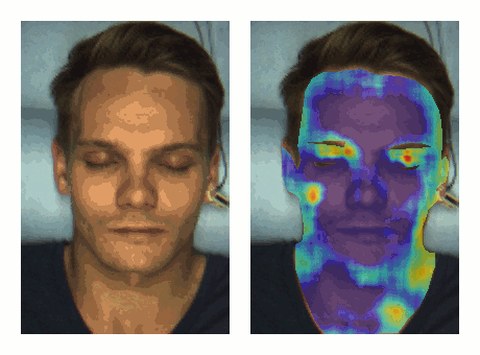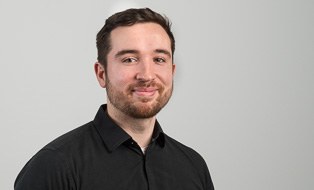Arbeitsgruppe Medizinische Messtechnik
Inhaltsverzeichnis
Überblick

Visualisierung der Druchblutung im Gesicht
Die Arbeitsgruppe Messtechnik verfolgt die Weiterentwicklung kontaktloser Messtechnik sowie die Untersuchung dieser im praktischen Einsatz. Im Fokus steht hierbei die kamerabasierte Erfassung physiologischer Parameter, wie beispielsweise Herzrate, Atemfrequenz und Blutsauerstoffsättigung.
Mit klinischen Partnern und durch Kooperationen aus Industrie und Forschung arbeitet die Arbeitsgruppe Medizinische Messtechnik in vielen unterschiedlichen Forschungsbereichen interdisziplinär zusammen, wobei speziell die anwendungsnahe Entwicklung im Vordergrund steht.
Die kontaktlose Messtechnik findet typischerweise im klinischen und häuslichen Umfeld (Ambient Assisted Living – AAL) Anwendung. Die möglichst einfache Überwachung wichtiger physiologischer Parameter gewinnt in Anbetracht des demographischen Wandels zunehmend an Bedeutung.
Mitarbeit
Interessenten haben jederzeit im Rahmen von Projekt-, Studien-, Diplom- und Masterarbeiten oder über WHK/SHK Tätigkeiten die Möglichkeit zur Mitarbeit an den Forschungsthemen und aktuellen Projekten der Arbeitsgruppe. Konkrete Anfragen richten Sie an Herrn Dipl.-Ing. Matthieu Scherpf (Kontakt siehe unten).
- Entwicklung einer regelbaren Beleuchtungseinheit zur gezielten farbabhängigen Ausleuchtung der aufgenommenen Hautareale
- Umsetzung der kamerabasierten Photoplethysmographie auf der Nvidia Jetson Nano Plattform
- Entwicklung einer Smartphone App zur Messung der Pulstransitzeit
-
Deep Learning für die Extraktion des Blutvolumenpulses in der kamerabasierten Photoplethysmographie
-
Deep Learning für die Blutdruckschätzung in der kamerabasierten Photoplethysmographie
-
Pulswellenanalyse zur Schätzung des Blutdrucks
-
Kamerabasierte Photoplethysmographie mittels Smartphone
Die hier aufgeführten Themen geben einen Einblick in die Forschungsschwerpunkte der Forschungsgruppe Medizinische Messtechnik. Individuelle Themenvorschläge sind jederzeit möglich und willkommen. Konkrete Anfragen richten Sie bitte an Dipl.-Ing. Matthieu Scherpf (Kontakt siehe unten).
Ausgewählte Projekte
Ziel des Vorhabens ist die Entwicklung innovativer Systeme und Verfahren zum Patientenmonitoring, welche bereits bei der Konzeption und Entwicklung die Bedienfreundlichkeit und den Patientenkomfort als Kernaspekte neben der inhaltlichen Funktionalität ansehen. Kernkomponente ist dabei die zur Anwendung kommende kontaktlose Messtechnik zur Erfassung von Vitalparametern. Diese soll physisch wie informationstechnisch in das häusliche Umfeld integriert werden. Durch altersgerechte Anwendungs- und Interaktionsmöglichkeiten und die Anbindung an die häusliche Informationsstruktur soll eine neue Generation von Medizintechnik entwickelt werden, die Barrieren auf Nutzerseite verringert, Patientenakzeptanz und -komfort deutlich steigert und so die Grundlage eines effizienten häuslichen Selbstmanagements legt.
Cyber-physische Produktionssysteme (CPPS) verknüpfen digitale und physische Systemkomponenten zur flexiblen, hochautomatisierten Erzeugung von Gütern. Derartige Produktionssysteme stellen andere Anforderungen als herkömmliche Massenproduktionsanlagen an die Mitarbeiter. Ziel des Graduiertenkollegs ist es daher, Erkenntnisse über Kompetenzen, Gesundheit und Vertrauen von Operateuren in CPPS zu gewinnen.
Das IBMT ist mit einer Doktorandenstelle am Graduiertenkolleg beteiligt, die in den beiden Arbeitsgruppen Medizinische Messtechnik und Biosignalverarbeitung verankert ist. Dabei geht es um die Einschätzung von Stress, Vigilanz und Schläfrigkeit. Übermäßiger Stress wirkt sich auf Dauer negativ auf die Gesundheit aus. Schläfrigkeit kann insbesondere in Überwachungs- oder Fahrzeugführerpositionen gefährliche Situationen hervorrufen. Dem aktuellen Zustand eines Menschen liegt der Status des autonomen Nervensystems und dessen Wechselwirkung mit dem Körper zugrunde. Es wird dementsprechend untersucht, mit welchen Mitteln auf den Status des autonomen Nervensystems zurückgeschlossen werden kann ohne die Person dabei an ihrer Tätigkeit im CPPS zu hindern.
Durch Auswertung der Farbkanäle einer RGB Kamera ist bei Aufzeichnung ausgewählter Hautareale die Erfassung bestimmter physiologischer Parameter möglich. Hierzu zählt beispielsweise die Herzrate. Die kamerabasierte Photoplethysmographie wird bereits seit mehreren Jahren am Institut erforscht. Nachfolgende Veröffentlichungen können für tiefergehende Informationen herangezogen werden.
-
S. Zaunseder, A. Trumpp, D. Wedekind, and H. Malberg, “Cardiovascular assessment by imaging photoplethysmography - a review,” (eng), Biomedizinische Technik. Biomedical engineering, vol. 63, no. 5, pp. 617–634, 2018.
-
S. Zaunseder, A. Trumpp, H. Ernst, M. Förster, and H. Malberg, “Spatio-temporal analysis of blood perfusion by imaging photoplethysmography,” in Optical Diagnostics and Sensing XVIII: Toward Point-of-Care Diagnostics, San Francisco, United States, Jan. 2018 - Feb. 2018, p. 32.
-
A. Trumpp et al., “Camera-based photoplethysmography in an intraoperative setting,” (eng), Biomedical engineering online, vol. 17, no. 1, p. 33, 2018.
- A. Trumpp, P. L. Bauer, S. Rasche, H. Malberg, and S. Zaunseder, “The value of polarization in camera-based photoplethysmography,” (eng), Biomedical optics express, vol. 8, no. 6, pp. 2822–2834, 2017.
-
A. Trumpp et al., “Skin Detection and Tracking for Camera-Based Photoplethysmography Using a Bayesian Classifier and Level Set Segmentation,” in Bildverarbeitung für die Medizin 2017, pp. 43–48.
-
A. Trumpp et al., “Relation between pulse pressure and the pulsation strength in camera-based photoplethysmograms,” Current Directions in Biomedical Engineering, vol. 3, no. 2, 2017.
-
D. Wedekind et al., “Assessment of blind source separation techniques for video-based cardiac pulse extraction,” (eng), Journal of biomedical optics, vol. 22, no. 3, p. 35002, 2017.
-
A. Trumpp, J. Schell, H. Malberg, and S. Zaunseder, “Vasomotor assessment by camera-based photoplethysmography,” Current Directions in Biomedical Engineering, vol. 2, no. 1, p. 21434, 2016.
-
S. Rasche et al., “Camera-based photoplethysmography in critical care patients,” (eng), Clinical hemorheology and microcirculation, vol. 64, no. 1, pp. 77–90, 2016.
Kontakt
 © IBMT
© IBMT
Arbeitsgruppenleiter
NameHerr Dipl.-Ing. Matthieu Scherpf
AG Medizinische Messtechnik
Eine verschlüsselte E-Mail über das SecureMail-Portal versenden (nur für TUD-externe Personen).
Besucheradresse:
Fetscherforum (F29), 1. OG, Raum 32 Fetscherstr. 29
01307 Dresden
